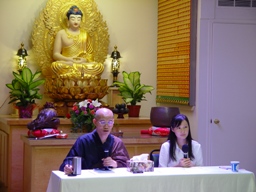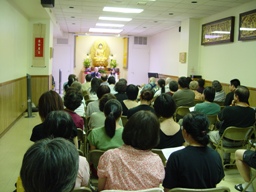The Infinite Mirror: Vexation is Itself Wisdom
Talk presented by Venerable Abbot Guo Xing
Report written by Chang Jie 06/06/2010
 On June 6, 2010, Venerable Abbot Guo Xing gave the third talk on The Infinite Mirror at CMC, focusing on the third stanza of "Inquiry into Matching Halves."
On June 6, 2010, Venerable Abbot Guo Xing gave the third talk on The Infinite Mirror at CMC, focusing on the third stanza of "Inquiry into Matching Halves."
Every (Dharma) door includes all realms,
Some mutually interact, others do not.
Reaction increases mutual involvement;
There should be no reliance on abiding in one place.
According to Venerable Abbot, the second stanza is related to the third stanza and is basically talking about how we all have Buddha nature, and that our minds and the Buddha's mind are actually the same, but our minds become confused. Originally, we were not human beings, but now we are human because of confusion and attachment. Shifu defined the first level of attachment as attachment to fame, monetary rewards, status and power.
The second level of attachment is to the body, health and immortality. In Buddhist terms, this is called attachment to the body and perceiving it as the self. If we are not attached to the body, then we may be attached to some mission or goal. For example, Joan of Arc was attached to the notion of virtue or being faithful to the country. This is attachment to an ideal. Another type of attachment that we don't usually think about is attachment to space and the world. We probably have not thought of it this way, but there really is no such thing as vast space, the world, sentient beings, or karma.
We can use the tai chi hexagram as an example. Everything comes from an origin, which branches out and creates many different kinds of phenomena. Like binary code, we start off with the notion of one, which becomes two, then four, and so forth. All of this was originally not in existence. The sutra talks about how the mind first moves, creating space, which leads to the world and all sentient beings, and all sentient beings create karma. Everything originally comes from the mind; one branches into two and two branches into four, until a myriad of phenomena arise. We talk about the world as being vast and wondrous; this all comes from the original mind.
"Inquiry into Matching Halves" is essentially about this dynamic relationship between Buddha nature and its ability to reflect all phenomena. We often think of Buddha nature and attaining Buddhahood as something that will happen in the distant future and is beyond our imagination, but, in fact, Buddha nature is in this very moment. There is a Chinese saying: Living in the present moment, and the Buddha is in the present moment as well. If you understand this principle, you will realize that at every moment, there is an opportunity for us to observe and experience Buddha nature. In fact, we and the Buddha are one, and not different. So what is Buddha nature? Do you have Buddha nature? Where is it?
Venerable Abbot told a story about a person who was in a car accident. He showed no vital signs and was announced dead. His body was sent to the morgue, and as it was being placed in cold storage, the body could not be placed inside because the knees were bent. As his body was being jammed in, this person suddenly woke up. People asked if he returned from the dead, and he responded that he did not die. He said that when he was hit by the car, he was clearly aware of everything. He knew that he did not have any vital signs, and that the ambulance took him to the hospital and morgue. During that time, he could not move his body or his thoughts. At that moment, where is your Buddha nature? Venerable Abbot invited the audience not to rely on their reading of the sutra, to discard terminology, and try to answer this question.
There is a saying: You carry the Buddha with you at every waking and sleeping moment. This means that Buddha nature is not far away. It is at the present moment. When we are talking, is there Buddha nature? When we are not talking, is there Buddha nature? When you die, is there Buddha nature?
Buddha nature, when manifested in your eyes, becomes seeing, when manifested in your nose, becomes smelling, when manifested in your ears, becomes hearing, when manifested in your legs, you stand up, at the time of rebirth, it is called the spirit. Buddha nature has another name-it is called the dharma body. It is said that the dharma body pervades the whole universe. In Chan Buddhism, Buddha nature is referred to as the mind. When we talk about seeing our own nature, it means our Buddha nature. Shifu refers to this as emptiness or the mind. Our mind has many different functions. When we engage in thinking, forms arise. When Buddha nature is manifested through your eyes, it has the function of seeing. When you see that there is an object or form, does the nature that is doing the seeing have a form as well? Does Buddha nature have form? When you see, do you think that your Buddha nature is in your eyes? We probably don't think in this way. Experientially, we use our minds to engage in the functions of seeing, hearing, breathing, getting angry, and feeling repentant. Experientially, is there a mind? When you have the thought that you don't want to see someone again, is this thought conjured from the mind? When you give rise to this thought, is your mind the same as this thought? If this thought is not your mind, where did it come from? This thought, which came from your mind, where did it go? Buddha nature is manifested at every moment; it is like the waves in the ocean, the function of the mind is a manifestation of the Buddha nature. When the waves rise, they are manifested, and when the waves calm down, they cease.
When I am talking to you, is there Buddha nature? Where is the Buddha nature? When you are angry, where is the Buddha nature? Does it stay with you, or does it go away from you? Does Buddha nature stand aside and observe you while you are angry, or does it engage along with you during this angry thought? What is the relationship between your anger and your Buddha nature? Venerable Abbot used the analogy of the mind brush versus the painting created by the mind brush. There is a saying that the mind brush is like a great painter. For example, when we get angry, the mind brush is your Buddha nature and the painting is your anger. The mind brush creates this phenomenon or painting that is anger. Is this anger phenomenon created by the mind brush? Is this angry painting the same as the mind brush? The problem is that when the mind brush creates this painting, we mistake the painting as the mind brush itself. The fact that you are mistakenly seeking this painting as the mind brush, this mistaken thought itself is the function of the mind brush. But the mind brush says, that's not true! But we ignore this all the time.
The next stanza describes the dynamic interaction between the mind brush and the painting. Is there anyone who does not have a mind brush and mind painting? There are about 50 to 60 people in the audience. So how many mind brushes are there? 60 brushes or 1? Many people said there is only one mind brush. When you go home, do you take this mind brush with you? If you don't take this home, then when you go home, you become a mindless person. Or can you compare this to the spiritual phenomena where the soul can be divided into many souls? If there are 60 mind brushes, each person has their own thoughts, feelings, pre-conceptions-the way you sit, move, and feel. Are these all different? According to the Chan school, there is no difference between nature and the phenomena.
All of us have Buddha nature. It doesn't matter whether Buddha nature is one or distinct. Do different people have different Buddha natures? The mind has the function of observing others as well as being aware of oneself, one's existence, thinking and feelings. The mind, when reflecting inwards, has the ability to be aware of the inner five skandhas, and when turned outward, is able to be aware of the external five skandhas. Another way to talk about it is, each of our bodies is the primary retribution and everything else is the dependent retribution. Whether we talk about the mind or the Buddha mind, we are basically talking about the function of the mind, its capacity to encompass all the phenomena of the mind, including the body, the self, and all external phenomena, such as mountains and rivers, and your thoughts. We can use the analogy of Indra's net, which is referred to by Shantideva, and is sometimes referred to as comprised of pearls or mirrors. If there are 100 mirrors, my own mirror has the ability to reflect the other 99 mirrors. Each individual mirror among the 99 mirrors is able to reflect and includes everything in the other 99 mirrors. The mirror does not have a physical form but has the function of a mirror. It has the ability to reflect everything. All 100 mirrors, when combined together, can they be categorized as one mirror or 100 mirrors?
 Another analogy is vast empty space. There are 60 people in the room, each with their own empty space. How many empty spaces are there? There is one vast empty space. But if you take your empty space home, does that mean the empty space has lost one corner? Our mind has the ability to reflect, but it does not have a physical form. This mirror has the ability to reflect. I am here reflecting the 60 people in the audience. Is this reflection or image of the mirror the same as the external phenomena? They are not the same. Of the 60 people here, different phenomena are being created. The phenomena may be different, but this empty space or reflective power is the same. It is hard to separate the two. Empty space, Buddha nature, and our minds all refer to the same thing. I am sitting here reflecting all of you. Let's say I have two different feelings-I like someone or dislike someone. It is all reflected in my mind.
Another analogy is vast empty space. There are 60 people in the room, each with their own empty space. How many empty spaces are there? There is one vast empty space. But if you take your empty space home, does that mean the empty space has lost one corner? Our mind has the ability to reflect, but it does not have a physical form. This mirror has the ability to reflect. I am here reflecting the 60 people in the audience. Is this reflection or image of the mirror the same as the external phenomena? They are not the same. Of the 60 people here, different phenomena are being created. The phenomena may be different, but this empty space or reflective power is the same. It is hard to separate the two. Empty space, Buddha nature, and our minds all refer to the same thing. I am sitting here reflecting all of you. Let's say I have two different feelings-I like someone or dislike someone. It is all reflected in my mind.
To simplify even more, let's say I am a mirror. This mirror has the ability to reflect 60 people here in the audience. Each of you has a mirror which has the ability to reflect 60 people as well. If we combine all of this, are there 3600 people here, or 60 people? I leave this room and carry the memory of the 60 people with me. Does that mean that I carry you with me? Did I take you with me? You say that I don't take them with me, but does that mean that I forget everything that happened here? 60 may be a lot of people to talk about. Let's simplify further and say there are two people. If you look carefully at two people, and remember them, when you leave this room, do you take them with you? Some people say, yes, some say no. You do take them with you. When you leave this room, you take the image with you. Have you had the experience of two people meeting and afterwards they each go home taking the image of the other person with them. Let's say these two people are lovers, and when they go their separate ways, the boy thinks about the girl and the girl thinks about the boy. Isn't it like this? Is the girl that is in the boy's mind, the actual girl? Is the boy that is in the girl's mind, the same as the real boy? Lovers might ask, did you miss me? The person that you're thinking about, the one that you miss, is not the same.
What is more fascinating is that my mind knows what is going on in your mind. Usually, ordinary people don't have this attainment or ability. In actuality, whatever appears in the other person's mind is already reflected clearly in my mind. Let's say there was this meeting and everyone goes home and there is this thought or memory of this meeting. The people that surface in your memory, are they real people or just your thought? What I just described is our common experience. Don't think there is no Buddha nature in there. Buddha nature is there the entire time. We usually mistake our memory as the actual person. This is called ignorance. When this image arises, you don't recognize it as an image, but as the actual person. Is ignorance a function of your own mind? Yes, it is. Ignorance is the truth and is the same as Buddha nature.
Our minds have the ability to give rise to all kinds of phenomena. My mind gives rise to all these phenomena, and your mind gives rise to these phenomena. My mind has the ability to be aware of the phenomena that arises from your mind, and your mind has the same ability to be aware of the phenomena in my mind. All these phenomena that arise from our minds interact with each other, and when we go our separate ways, they stop interacting with each other. Sometimes they are one, and sometimes they are separate.
Let's say there are two people. Both of their minds have the ability to reflect phenomena. When they meet, one person's mind reflects the phenomena of both people. Let's say both people have complete enlightened Buddha nature and don't have vexations in their minds at all. The image phenomena that arise in both people's minds will match perfectly and correspond perfectly with each other.
Let's say one person has complete enlightenment with no vexations or wandering thoughts whatsoever, but the other person doesn't. When the two people meet, the enlightened person's mind will reflect the situation perfectly, but the unenlightened person will have all these wandering thoughts, and will make distinctions between self and other. Do the two minds correspond perfectly in this case?
When I have these wandering thoughts and distinctions, such as Fashi is Fashi and I am I, am I able to reflect clearly what is happening in his mind? If the two people are perfectly enlightened and don't have attachments, wandering thoughts or vexations, when the two meet and one person says, Bastard! will the other person think, why is that person calling me bastard? Or will you simply clearly reflect that someone said the word? If you understand what I am talking about, when you look at all the kong-ans from the Chan schools and records, you will be able to see that that is how they usually interacted with each other. For example, if I say, why did the Patriarch come from the west, the other person would reflect and have a clear reflection of the words that were uttered. The person who listens will whack the other person's head, and the act of whacking will be clearly reflected. It is a clear reflection of the phenomena that arises.
This is a key concept in the Inquiry into Matching Halves, the idea of interacting with each other. If you really understand this concept, then you could take it with you, apply it at every moment, and observe whether your reflection is erroneous at any given situation.
